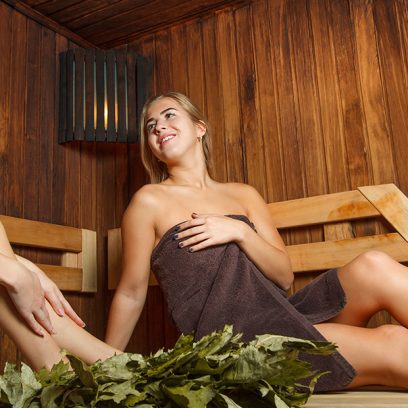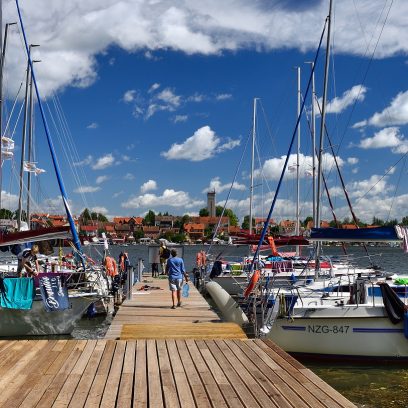



Od Ostródy po Ryn – jeśli chcemy zwiedzić Warmię i Mazury Szlakiem Zamków Gotyckich musimy przygotować się na długą podróż. Długą i pełną zaskakujących odkryć. Bo zamki, jak na średniowieczne budowle przystało, kryją w sobie niejedną tajemnicę.
Szlak Zamków Gotyckich łączy warownie państwa krzyżackiego w granicach obecnych województw: warmińsko-mazurskiego, kujawsko-pomorskiego i pomorskiego. Podążanie szlakiem po Warmii i Mazurach zaczniemy od Zamku krzyżackiego w Ostródzie wzniesionego w pobliżu Jeziora Drwęckiego u ujścia rzeki Drwęcy. Niegdyś w zamkowych stajniach trzymano najważniejszy „towar eksportowy” Krzyżaków – konie bojowe. Z uznaniem wyrażali się o nich nawet Prusowie, którzy sami słynęli z handlu końmi. Według historyków były one protoplastami koni trakeńskich, których systematyczną hodowlę rozpoczęto około XVIII w.
Fot. Muzeum w Ostródzie
Jadąc na południe, dotrzemy do Nidzicy, nad którą góruje największy zamek krzyżacki na Mazurach. Co ciekawe, ale niezbyt chlubne, w czasach Prus Książęcych należał on do miejsc, w których przeprowadzono najwięcej procesów o czary. Z okresem potopu szwedzkiego wiąże się natomiast legenda o Tatarskim Kamieniu. Kula wystrzelona w jego kierunku z zamkowej armaty miała zniechęcić Tatarów do zdobywania miasta.
Z Nidzicy już niedaleko do Działdowa. W zrewitalizowanym skrzydle zamku krzyżackiego działa Muzeum Pogranicza. Należąca do tej placówki interaktywna wystawa Państwa Krzyżackiego została w 2014 r. uznana za jeden z „7 nowych cudów Polski” w plebiscycie organizowanym przez National Geographic Traveler.
Kierując się na północ, nie sposób ominąć Olsztyna. W tutejszym zamku kapituły warmińskiej przez kilka lat rezydował Mikołaj Kopernik. Pamiątką po jego pobycie jest tablica astronomiczna na ścianie krużganka, która służyła do przedstawienia pozornego ruchu Słońca w dniach bliskich równonocy wiosennej. Jest to jedyny na świecie zachowany instrument wykonany i używany przez Kopernika.
Kopernik mieszkał też w zamku biskupów warmińskich w Lidzbarku Warmińskim. Budowla do dzisiaj wzbudza zachwyt zarówno swoimi rozmiarami, jak i skarbami ukrytymi wewnątrz. Gdy sądzono, że poznano już wszystkie tajemnice zamku, w trakcie prac remontowych znaleziono fragmenty zabudowy, które mogły być wzniesione wcześniej niż warownia. Z kolei na parterze, na zapleczu kuchni oraz w piwnicy odkryto polichromie, będące czymś wyjątkowym dla zamków z tego okresu.
Wracając na Mazury, znowu natykamy się na siły nadprzyrodzone. O konszachty ze złymi mocami bywali oskarżani masoni. Pamiątki po ich działalności możemy zobaczyć wśród eksponatów Muzeum im. Wojciecha Kętrzyńskiego, mającego siedzibę w zamku krzyżackim w Kętrzynie. Loża masońska w tym mieście została założona w 1818 r. i funkcjonowała aż do czasu delegalizacji przez III Rzeszę. Jednak jej siedzibę, w stylu neogotyku angielskiego, możemy podziwiać do dzisiaj.
Naszą podróż zakończymy w Rynie. Z tutejszym zamkiem krzyżackim związana jest historia z duchem w roli głównej. Białą damą, która nawiedza ryńskie komnaty, ma być żona wielkiego księcia litewskiego Witolda. Marzący o królewskiej koronie Witold wielokrotnie bywał w zamku, spiskując z Krzyżakami i licząc na ich pomoc. Jako gwarancję przejścia na ich stronę pozostawił w Rynie żonę Annę i dzieci. Gdy jednak nie zdradził Jagiełły pod Grunwaldem, Krzyżacy mieli zamurować jego rodzinę w piwnicach. Wbrew tej legendzie historycy uparcie twierdzą, że Anna zmarła kilka lat później w Trokach.
Duchy, czary i Tatary, cuda, Kopernik i owiane legendą konie. Wędrując Szlakiem Zamków Gotyckich na Warmii i Mazurach, poznamy nie tylko historię ich murów i mieszkańców, ale też doświadczymy wyjątkowości każdego z nich.

Wśród jezior, lasów i ogrodów, gdzie mikroklimat sprzyja odpoczynkowi, znajdziecie miejsca, w których zrelaksujecie wszystkie zmysły. Holistyczne podejście do człowieka, zadbanie nie tylko o ciało, ale też o wyciszenie i wewnętrzny spokój, to klucz do szczęścia. Poznajcie najbardziej doceniane obiekty spa i welness na Warmii i Mazurach.
Dowiedz się więcej
Odetchnij na Warmii i Mazurach. Ciesz się zapachem lasu, podziwiaj piękno mazurskich jezior, odpoczywaj i relaksuj się od codziennych spraw w wybranych hotelach i ośrodkach na Warmii i Mazurach!
Dowiedz się więcej
Jak powszechnie wiadomo, nasze zdrowie zależy w dużej mierze od nas samych. Właściwe odżywianie i aktywny styl życia to czynniki, które mają duży wpływ na nabycie lepszej odporności. A ta jest bardzo ważna nie tylko w dobie pandemii koronawirusa.
Dowiedz się więcej